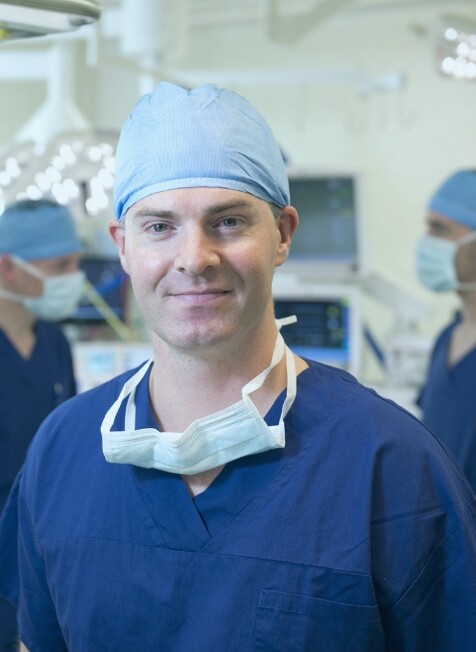Shoulder Arthroscopy
Shoulder arthroscopy is a surgical procedure to relieve subacromial impingement or bursitis.
One of the problems that can impede proper shoulder movement is called subacromial impingement or bursitis. The shoulder is one of the body’s most complex structural mechanisms. It gives us a range of motion greater than any other joint in our bodies.
Multiple elements within the shoulder socket, upper arm, and collarbone need to work together to allow full arm motion. If one contributor to the overall movement process becomes unable to do its job effectively, it can result in limited movement and shoulder pain.

What is Subacromial Impingement?
The terms impingement and bursitis refer to different parts of the same issue.
Shoulder impingement is a condition where the rotator cuff tendons are intermittently trapped and compressed during shoulder movements.
Between the bones at the tip of our shoulder lie a group of tendons that are part of our rotator cuff. Usually, tendons slide smoothly through the area.
But sometimes the space between our arm bone and the tip of our shoulder (acromion) becomes too narrow for tendons to easily slip through. When this happens, raising the arm above shoulder height pinches the rotator cuff tendons between our arm and acromion bones. The more this pinching happens, the more inflamed and irritated the tendons become.
What is Shoulder Bursitis?
Likewise, this rubbing and compressing can also affect the subacromial bursa.
Bursas are cushion-like sacs filled with lubricating fluid that sit between our tendons and bones. Their purpose is to ensure tendons glide smoothly next to our bones.
We have hundreds of bursas in our bodies. When shoulder bursae become inflamed, it’s called subacromial bursitis.
What causes subacromial bursitis?
Generally, subacromial bursitis is caused by impingement from repetitive or forceful use of the shoulder. It can also be caused by the shape of the shoulder bone.
Overhead lifting, forceful pulling, and a knock to the shoulder can all cause subacromial bursitis. Also, being very active in sport that involves repeated overhead movements, such as tennis, golf, swimming, or throwing a ball can cause the bursa to flare up.
Other factors that can contribute to bursitis are advancing age, poor posture, and not stretching properly before and after a workout.
Symptoms of Subacromial Impingement or Bursitis
The main symptom of shoulder impingement or bursitis is persistent pain bad enough to affect everyday activities.
More specifically, symptoms can include:
- Shoulder pain that extends from the top of the shoulder to the elbow
- Pain when lying on the sore shoulder
- Shoulder pain, even when the shoulder is resting
- Muscle weakness and pain when attempting to reach or lift
- Pain when putting your hand behind your back or head (such as when getting dressed)
- Shoulder pain while sleeping
If you have subacromial bursitis, you may also notice redness and swelling in your shoulder. It may be sore to touch and feel ‘hot’. In advanced cases of bursitis, you might not be able to move your shoulder at all (frozen shoulder).
Shoulder Impingement/Subacromial Bursitis Diagnosis
Diagnosis of the issue begins with a medical examination.
Dr McLean will discuss your symptoms and ask you some questions about your medical history before physically examining your shoulder.
During your physical examination, Dr McLean will look for any unusual bone formations and test for tenderness in any area of your shoulder. He may also examine your neck to make sure your pain isn’t caused by a pinched nerve and also to rule out any other conditions, such as arthritis.
Next, Dr McLean will measure your shoulder’s range of motion by moving your arm in several directions. He will also test your arm strength. Two clinical diagnostic tests that are commonly performed when dealing with shoulder subacromial impingement are the Neer test and the Hawkins-Kennedy test.
Treatment for Shoulder Impingement or Subacromial Bursitis
Non-surgical treatment for shoulder impingement and subacromial bursitis
Initial treatment is non-surgical. It focuses on avoiding the activities that caused the problem to occur, using anti-inflammatories to resolve any swelling, and following a set of shoulder exercises designed to stretch and strengthen the muscles affected.
If prescribed shoulder exercises aren’t helping improve bursitis, cortisone injections are sometimes used to deliver the powerful anti-inflammatory straight into the bursa. This procedure is usually done under ultrasound control to ensure the cortisol is delivered to its optimal place.
The cause and severity of shoulder impingement or bursitis influence how well it responds to treatment. In some cases, the issue will respond positively to a single treatment session. In more complicated cases, the injury may take a few weeks or months to settle down. Other cases may require surgery to correct the issue.

Shoulder arthroscopy for impingement and bursitis
If your symptoms persist beyond three to six months, surgery may be recommended to resolve the problem.
Shoulder surgery aims to create more space for the tendons underneath the acromion to prevent them from impinging against the bone. Surgery can also remove inflamed tissue from the bursa or remove the bursa altogether if necessary (a new one will grow back). This process is referred to as subacromial decompression.
Subacromial decompression is an arthroscopic (key-hole) procedure in which tiny surgical instruments are inserted into the shoulder through small incisions. Among these instruments is a small camera that allows orthopaedic surgeon Dr James McLean to see the inside of the shoulder and perform repairs without opening the shoulder up.
During the procedure, Dr McLean removes bone tissue to increase the amount of space under the acromion, allowing rotator cuff muscles and tendons to move more freely underneath it. He may also remove any bone spurs if any have developed.
Because of the small-scale nature of an arthroscopy, pain is minimal, and healing is fast. Patients often go home the same day and are back to their regular activities within weeks. Arthroscopic procedures are also favourable because they minimise the risk of infection as opposed to a traditional open-surgical procedure.
Shoulder Arthroscopy Recovery
Rehabilitation plays an important role in getting you back to your normal routine.
After your surgery, Dr McLean will create a shoulder exercise program that’s designed to help regain your shoulder’s strength and motion.
Shoulder exercises may include a range of light weights, stretching, and assisted rotation exercises. As your rehabilitation progresses, Dr McLean will gradually adjust your exercise schedule and advise what level of activities you should be doing with your arm.
Shoulder arthroscopy recovery time typically takes between 2 and 4 months before complete relief from shoulder pain is achieved, but every case is different. Dr McLean will monitor your recovery and work with you to ensure you are back to proper function with minimal delay.
Read more:
Patient resources for shoulder conditions
Dr James McLean is an Orthopaedic surgeon based in South Australia. He practices at several locations around Adelaide, including Ashford, Elizabeth Vale, Bedford Park and Parkside. Check out Dr McLean’s articles on shoulder-related and post-surgery information.
How Dr James McLean can help
Dr James McLean is an orthopaedic surgeon providing consultations and various treatments for a wide variety of shoulder conditions in Adelaide.
With his extensive experience in treating upper limb conditions, he works with his patients to create tailored treatment plans which yield the best possible outcomes for their injuries.
Click here for more information on other conditions involving the shoulder, hand, wrist, and elbow which Dr James McLean has a special interest in treating.
Once you have a referral…
Book your consultation here.

